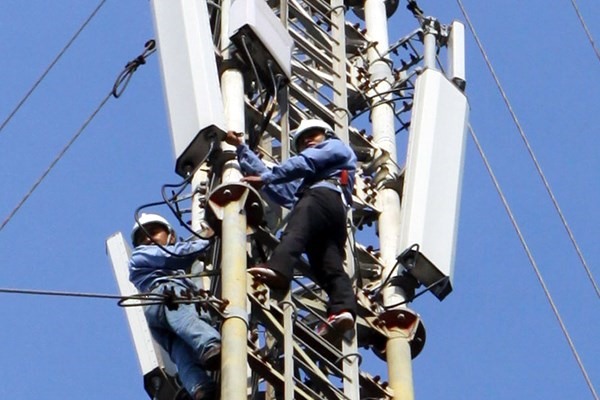|
|
| Workers on a base transceiver station (BTS) in the capital city. — VNA/VNS Photo Minh Tú |
Only about 1,300, or 16 per cent, of the 8,100 BTS devices in the capital are being shared among various network providers, according to data compiled by the city’s Department of Information and Communications (MIC).
Although accounting for 66 per cent of the total number of antennae installed on city rooftops, the allocation of these 8,100 BTS is haphazard. As a result, two to three BTS devices used by different providers can be found on the same stretch of street in the inner city’s districts of Đống Đa and Ba Đình, the Kinh tế & Đô thị (Economic & Urban Affairs) newspaper reported. It is also common to see several BT stations of different network providers installed on the rooftop of the same building.
Despite MIC’s constant encouragement of BTS site sharing, network providers balk at the idea due to technical difficulties and cost inefficiency, according to the report. Only 100 sites are being shared after a one-year campaign started in 2010 by the city’s People’s Committee, it said.
The telecommunications infrastructure plan for the capital city until 2020, launched on August 30, targets an increase in the percentage of infrastructure sharing to 30-35 per cent by 2020.
Each BTS site must be shared by two to four providers within a radius of 100m, according to the plan. Network providers wishing to install new antenna masts must do so on the same site as the nearest existing ones.
Safe BTS
Responding to residents’ concerns that electromagnetic waves transmitted by BTS antennae may harm their health, Ministry of Science and Technology (MOST) inspections indicate that the radiation within 300m of the BT stations is safe for humans, based on recommendations of the International Telecommunication Union (ITU) and World Health Organisation (WHO), the newspaper reported.
The city is also encouraging network providers to develop “green” BTS installations that are environmentally friendly and able to serve different purposes, according to Kinh tế & Đô thị.
In January, MobiFone became the first network provider to respond to the request, piloting 10 BTS installations with clean designs that resemble white water tanks on major streets in the city.
The network provider said it would install some 300 additional environmentally friendly BTS in the city, which will even double as travel information racks containing city and bus maps to serve tourists. Some will incorporate public lighting, wi-fi transmission and traffic camera systems.

